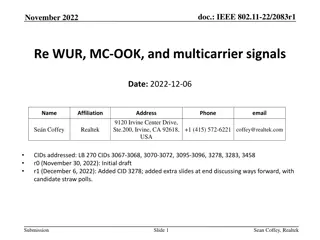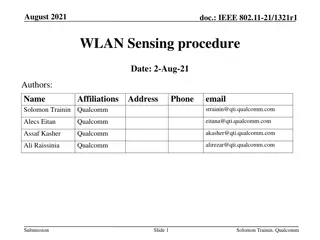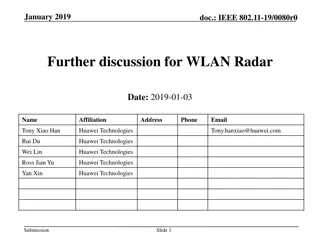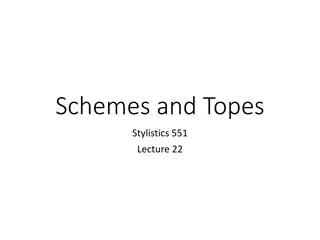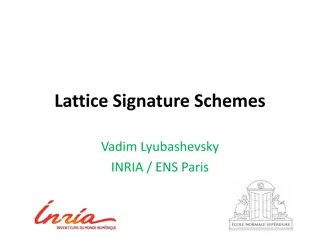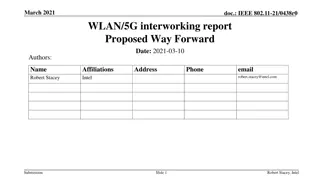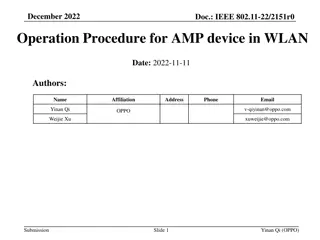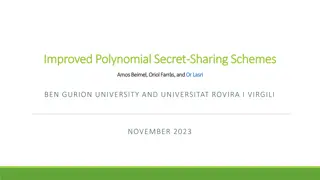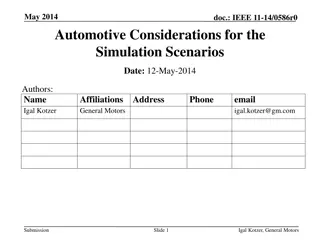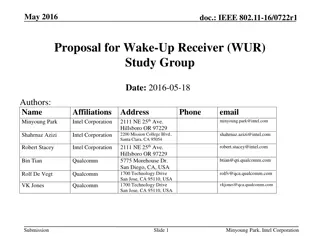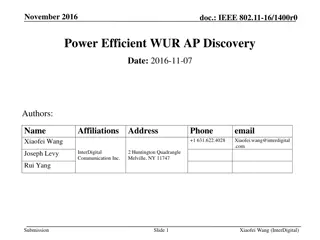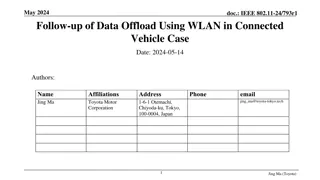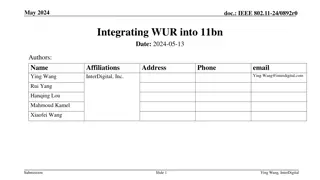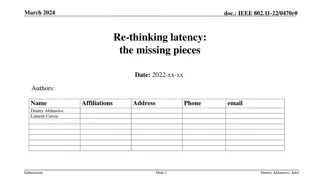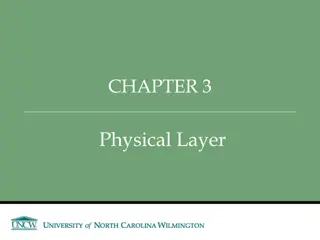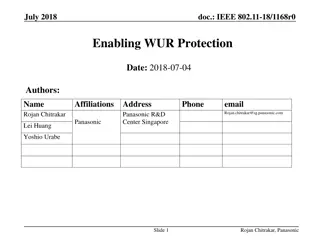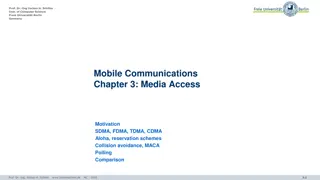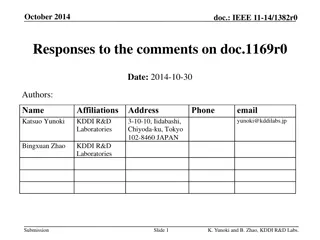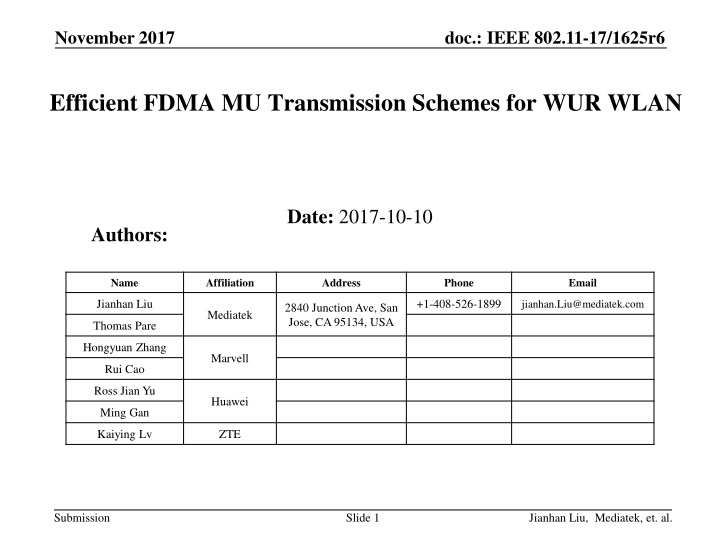
Efficient FDMA MU Transmission Schemes for WUR WLAN
Explore the IEEE 802.11-17/1625r6 document presenting efficient FDMA MU transmission schemes for Wake-Up Radio (WUR) Wireless LAN (WLAN), aiming to reduce power consumption and enhance wake-up operations for IoT devices, focusing on multi-user wake-up operations and FDMA wake-up efficiency.
Download Presentation

Please find below an Image/Link to download the presentation.
The content on the website is provided AS IS for your information and personal use only. It may not be sold, licensed, or shared on other websites without obtaining consent from the author. If you encounter any issues during the download, it is possible that the publisher has removed the file from their server.
You are allowed to download the files provided on this website for personal or commercial use, subject to the condition that they are used lawfully. All files are the property of their respective owners.
The content on the website is provided AS IS for your information and personal use only. It may not be sold, licensed, or shared on other websites without obtaining consent from the author.
E N D
Presentation Transcript
November 2017 doc.: IEEE 802.11-17/1625r6 Efficient FDMA MU Transmission Schemes for WUR WLAN Date: 2017-10-10 Authors: Name Affiliation Address Phone Email Jianhan Liu +1-408-526-1899 jianhan.Liu@mediatek.com 2840 Junction Ave, San Jose, CA 95134, USA Mediatek Thomas Pare Hongyuan Zhang Marvell Rui Cao Ross Jian Yu Huawei Ming Gan Kaiying Lv ZTE Submission Slide 1 Jianhan Liu, Mediatek, et. al.
November 2017 doc.: IEEE 802.11-17/1625r6 Operation of WUR To reduce power consumption, even the WUR will not be always on. In each beacon interval, there is a 2ms awake window for WURs. The duration of a WUR frame can be about 1ms. For example, with 48bits date field, the duration is about 800us. With 60 bits data field, the duration is over 1ms (60*16us+40us~1ms). We need to enhance the efficiency of wake-up operations. To avoid reducing the WLAN network throughputs due to wake-ups, especially with a lot of stations without WURs. Submission Slide 2 Jianhan Liu, Mediatek, et. al.
doc.: IEEE 802.11-17/1625r6 Multi-user (MU) Wake-up Operations Enabling MU wake-up operations enhances efficiency significantly If a WUR frame wakes up 2 stations one time, the efficiency increases 100%! Enabling MU wake-up operations is a good approach to fully exploit the advantages provided by11ax MU transmissions. Most WUR stations for IOT and they just need to transmit/receive short data packets. 11ax OFDMA transmissions achieves highest efficiency for short packets. If the WUR station needs to be waked up one by one, then they are likely to be waked in different beacon interval or awake window. 11ax OFDMA transmission is hard to use. MU wake-up operations by grouping wake-up only has limitations too. Grouping management adds a lot of overhead. For example, group ID update, re-grouping, etc. It is not flexible and not efficient when there are large number of groups. Submission Slide 3 Jianhan Liu, Mediatek, et. al.
doc.: IEEE 802.11-17/1625r6 FDMA MU wake-up operations (continues) Compared to MU wake-ups using grouping method, FDMA MU wake-up operations is particularly useful for wake-up a small number of WUR stations. Enabling FDMA MU wake-up does not increase any cost at TX and RX. At TX, AP just need to use the sub-carries of the multiple sub-channels using OFDM. There is no cost at all at TX. At RX, each WUR station only needs to operated on the sub-channel that assigned to it during the association. There is no extra cost because WUR receiver already has mixer. For BSS with wide BW than 20MHz, it is a waste just allow one 11ba channel in the primary 20MHz channel only. Submission Slide 4 Jianhan Liu, Mediatek, et. al.
doc.: IEEE 802.11-17/1625r6 FDMA Transmissions (Scheme A) Legacy Preamble Spoof Symbol Wake-Up Signal for WUR Station #n 20MHz Legacy Preamble Spoof Symbol Wake-Up Signal for WUR Station #n 20MHz Legacy Preamble Spoof Symbol Wake-Up Signal for WUR Station #m 20MHz Legacy Preamble Legacy Preamble Spoof Symbol Wake-Up Signal for WUR Station #k Spoof Symbol 20MHz Wake-Up Signal for WUR Station #m 20MHz Legacy Preamble Spoof Symbol Wake-Up Signal for WUR Station #l 20MHz Figure a. FDMA MU WUR OOK transmissions using 40MHz bandwidth Figure b. FDMA MU WUR OOK transmissions using 80MHz bandwidth Each 20MHz only contain one 4MHz sub-channel for wake-up signal transmission. Similar to 11ax s 20MHz only operation, one wake-up receiver can stay in one of the sub-channel in wide bandwidth. Submission Slide 5
doc.: IEEE 802.11-17/1625r6 Channelization for Scheme A Each 20MHz channel only contain one 4MHz sub-channel as shown in the following figure. ACI 4MHz 8MHz 8MHz Sub-channel 20MHz Channel Submission Slide 6
doc.: IEEE 802.11-17/1625r6 Advantages of FDMA Transmissions of Scheme A Compared to other FDMA transmissions such as schemes shown in the appendix, Scheme A does not add extra complexity. FDMA Transmission Schemes A significantly enhance the spectral efficiency in BSS with operation BW that is greater than 20MHz. Note that the BSS based on 11ac and 11ax are likely be 80MHz or larger. 11ba station is most likely HE stations, they can take the advantage of OFDMA reception after wake up by FDMA Transmission Schemes A. The enhance of spectral efficiency of 11ba helps the whole network throughput and therefore is helpful for market success of 11ba technology. FDMA Transmission Schemes A enables the discovery efficiently. FDMA Transmission Schemes A greatly allows larger number of 11ba STAs in one BSS. Submission Slide 7
doc.: IEEE 802.11-17/1625r6 Motion #1 Do you agree to add the concept FDMA transmission scheme shown in the slide 5 to the 11ba SFD? Note: FDMA transmission is only allowed in the BSS with wide bandwidth greater than 20MHz. Submission Slide 8
doc.: IEEE 802.11-17/1625r6 Appendix: Other FDMA MU transmission Schemes Submission
doc.: IEEE 802.11-17/1625r6 FDMA MU transmissions (Scheme B) Based on the interference analysis with a low-cost analog filter, there are two possible FDMA MU transmissions. Submission Jianhan Liu, Mediatek, et. al.
doc.: IEEE 802.11-17/1625r6 Channelization for two Sub-channel Scheme Each 20MHz Channel can be divided into two 4MHz sub- channels as shown in the following figure. Transmitter transmits OOK wake-up signal on each sub-channel to a station with WUR receiver. The protection frequency band between two sub-channels and enamoring 20MHz WiFi channel is 4MHz. It enables low-cost and low-power filter to reduce the adjacent channel interferences (ACI). Submission Jianhan Liu, Mediatek, et. al.
doc.: IEEE 802.11-17/1625r6 Channelization for three sun-channel scheme Each 20MHz channel can be divided into three 4MHz sub- channels as shown in the following figure. Transmitter transmits OOK wake-up signal on each sub-channel to a station with WUR receiver. The protection frequency band between three sub-channels and enamoring 20MHz WiFi channel is 2MHz. It enables low-cost and low-power filter to reduce the adjacent channel interferences (ACI). Submission Jianhan Liu, Mediatek, et. al.


